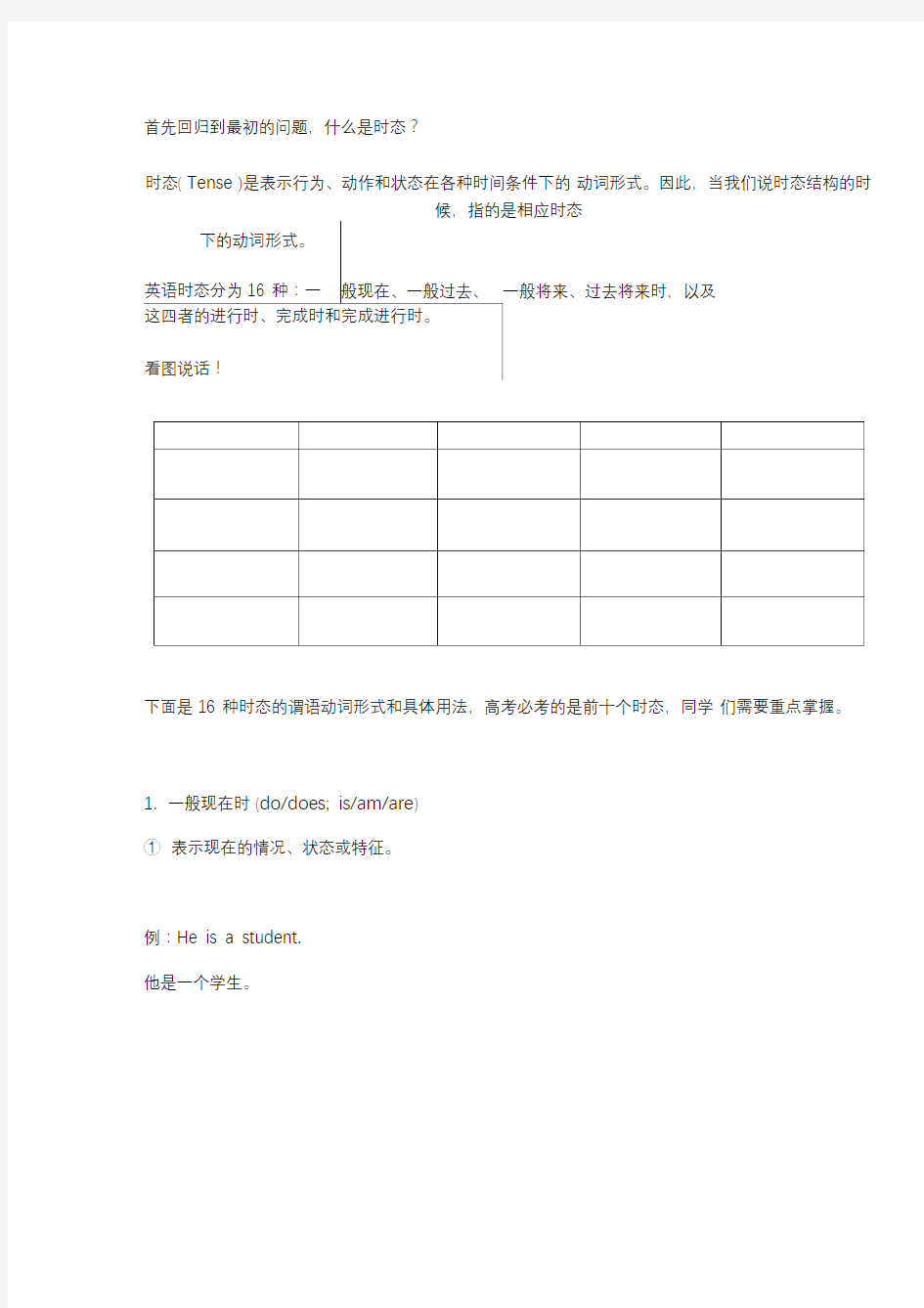英语中的16个时态


首先回归到最初的问题,什么是时态?
时态( Tense )是表示行为、动作和状态在各种时间条件下的动词形式。因此,当我们说时态结构的时
下面是16 种时态的谓语动词形式和具体用法,高考必考的是前十个时态,同学们需要重点掌握。
1.一般现在时 (do/does; is/am/are )
①表示现在的情况、状态或特征。
例:He is a student.
他是一个学生。
例:He always helps others.
他总是帮助别人。
③客观事实和普遍真理。
例:The earth moves the sun.
地球绕着太阳转。
④表示一个按规定、计划或安排要发生的动作。
仅限于某些表示“来、去、动、停、开始、结束、继续”等的动词,可以与表示未来时间的状语搭配使用。
常见的用法是:飞机、火车、轮船、汽车等定期定点运行的交通方式。
例:The next train leaves at 3 o'clock this afternoon. 下一趟火车今天下午3 点开车。
⑤在时间、条件和让步状语从句中经常用一般现在(有时也用现在完成时)表示将的来事情。(即:主将从现原则)
例:I will call you as soon as I arrive at the airport.
我一到机场就会给你打电话。
When you have finished the report, I will have waited for about 3 hours.
等你完成这份报告的时候,我就已经等了将近3 个小时了。
2.现在进行时(am/is/are doing)
例:He is listning to the music now.
他现在正在听音乐。
②表示目前一段时间内一直在做的事情,但不一定此时此刻正在做。例:I am studying computer this term.
这个学期我一直在学习计算机。
③现在进行时可以表示将来的含义。
瞬时动词的进行一定表将来。
例:I am leaving.
我要离开了。
持续动词的进行只有有将来的时间状语或有将来语境中才表将来。
例:I am travelling next month.
下个月我要去旅行。
④现在进行时与频度副词连用,表示说话者或褒义或贬义的感情色彩例:He is always helping
others.
他总是帮助别人。(褒义)
3.现在完成时(have/has done)
①表示动作到现在为止已经完成或刚刚完成,强调对现在产生的影响。
例:I bought a new house, but I haven't sold my old one yet, so at the moment I have two houses.
我买了一所新房子,但是还没有卖掉旧的,所以现在我又两所房子。
②表示从过去某时刻开始,持续到现在的动作或情况,并且有可能会继续延续下去。此时经常用延续性动词。
时间状语常用since 加一个过去的时间点,或for 加一段时间,或by 加一个现在时间。
例:Great as Newton was, many of his ideas have been challenged today and are being modified by the work of scientists of our time.
虽然牛顿是个伟大的人物,但他的许多见解直到今天还在受到挑战,并且被现代科学家的工作所修正
4.现在完成进行时(have/has been doing) 表示某一动作开始于过去某一时间,延续或重复地出现至今,或将继续延续至将来。
例:We have been working on this project for over a month now. 到目前为止,我们一直在处理那个项目,已经花了一个多月时间了。
5.一般过去时(did; was/were)
①表示过去某个时间发生的动作或情况。
例:I bought some fruits yesterday.
我昨天买了一些水果。
例:When I was a boy,I often swam in that river.
would/used to do :表示过去常常.......
例:The old man would sit on a bench in the quiet park and look at others for hours without doing anything or talking to anybody.
老人过去常常坐在宁静的公园里的一条长椅上,看着其他的人,一坐就是数个小时,什么也不干,也不和任何人交谈。
He used to visit his mother once a week.
他以前总是每周看望一次他的母亲。
6.过去完成时(had done)
表示在过去的某个时间或动作以前已经发生的动作或已经存在的状态。就是我们常说的"过去的过去"。
Until then, his family hadn't heard from him for six months. 到那时为止,他家里已经有六个月没得到他的消息了。
7.过去将来时(would do)
表示从过去的某个时间看将要发生的事。
例:I said on Thursday I should see my friend the next day.
我星期四说我将于第二天拜访我的朋友。
8.过去进行时(was/ were doing)
① 表示在过去具体的时间正在发生的动作。
例:Mary was listening to light music 10 minutes ago.
10 分钟前,玛丽正在听轻音乐。
例:I was travelling in London last summer vacation.
去年暑假我在伦敦旅行。
③过去进行时可以表示过去将来的含义。
瞬时动词的过去进行时一定表示过去将来的含义。
例:Then she said she was leaving.
然后她说她要离开了。
持续动词的过去进行时只有在有过去将来的时间状语或过去将来的语境下才能表示过去将来。
例:She said that she was travelling the next day.
她说她第二天要去旅行。
④过去进行时和频度副词连用可以表示说话者或褒义或贬义的感情色彩。
9.一般将来时
(1)will do
① 表示主语主观意愿的将来。
例:I will send her a glass hand-made craft as her birthday gift. 我将送给她一个玻璃的手工制品,作为给她的生日礼物。
②表示客观将来。
例:Fish will die without water.
离开水,鱼会死。
③表示临时决定。
例:——Mary has been ill for a week.
——Oh,I didn't know. I will go and see her.
(2)am/is/are going to do
① 表示计划、打算做某事。
例:This is just what I am going to say.
这正是我想说的。
② 表示根据某种迹象看,很可能或即将发生的事情,表推测。例:Look at the dark clouds in the sky. It's going to rain.
看天上的乌云,要下雨了。
(3)am/is/are about to do
表示“即将、正要”时,可用。强调近期内或马上要做的事例:Don't worry, I am about to make a close examination on you.
别担心,我马上就给你做一次仔细的检查。
4) be to do
① 表示“按计划、安排即将发生某事或打算做某事”。例:She is to be seen in the lab on Monday.
星期一你准会在实验室见到她。
② 该做或不该做的事情(语气上接近于should, must, ought to, have to ),表示一种命令、规劝性语气。
例:You are to go to bed and keep quiet, kids. Our guests are arriving in less than 5 minutes. 孩子们,你们必须上床睡觉,不准吵闹。我们的客人5 分钟之内就要到了。
10.将来进行时(will be doing) 强调在将来的某个具体时间正在发生的动作或事情。例:Don't worry, you won't miss her. She will be wearing a red T-shirt and a white skirt at that time.
别担心,你不会认不出她的。她到时会穿一件红色的T 恤衫和一条白色的短裙。
11.将来完成时(will have done) 表示从将来的某一时间开始、延续到另一个将来时间的动作或状态,或是在某个将来时间完成,但对其后的另一个将来时间有影响的动作或状态。就好象把现在完成时平移到时间轴的将来时时段一样。
例:The conference will have lasted a full week by the time it ends. 会议从开始到结束将持续整整一个星期。
12.将来完成进行时:(will have been doing)
例:By the end of next month, the project will have been being worked for 3 years.
到下个月底为止,这项工程就已经不停地进行了3 年了
13.过去完成进行时:had been doing
例:The old clock had been being taken apart of and fixed up again for several times by my 10-year old son before I came back home.
我回到家之前,我10 岁大的儿子已经把这个旧钟表拆卸并重新组装了好几回了。
14.过去将来进行时:( would be doing )
例:The government promised that a new highway would be being built next July.
政府承诺说第二年7 月将有一条新的高速公路正在修建。
15.过去将来完成时:(would have done)
例:I believed by the end of that year an advanced version of that software would have been developed, but I was wrong.
我坚信到那年年底为止,那个软件的新版本将被开发出来。但是我错了。
16.过去将来完成进行时:(would have been doing)
例:They said that by the end of the following month, the project would have been being worked for 3 years.
他们说到第二个月底为止,这项工程就已经不停地进行了3 年了
